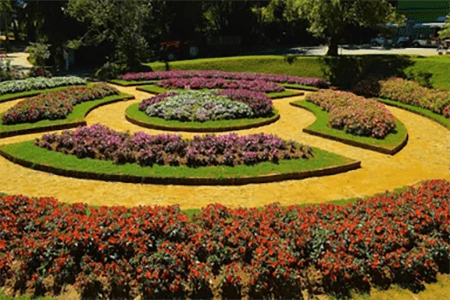One of the three botanical gardens established by the British in Sri Lanka. The garden was originally established to experiment with the medicinal crop Cinchona in 1861. The 20ha garden is the second largest botanical garden in Sri Lanka.
The Hakgala botanical gardens with subtropical and tropical plants adjoin the Hakgala Strict Nature Reserve which habitats a variety of flora and fauna.
It lies at an elevation of approximately 1745 meters above mean sea level. Hence the weather is comfortably cool.
Additional information
Nearby Attractions
The most popular nearby attraction
- Gregory Lake
- Nuwara Eliya
- Nuwara Eliya Golf Club- Nuwara Eliya
- Pidurutalagala Mountain
Pidurutalagala, at 2,524 meters, is Sri Lanka’s highest peak. The Pidurutalagala mountain range is a major watershed in Sri Lanka and has a highly sensitive biodiversity habitat. It homes to leopards live in the highland.
According to British colonial-era records, the summit was a famous place to visit, and there were hiking paths to the mountain in the early twentieth century. But now, the public must seek permission to drive up to the peak since it is the key telecommunications hub in the country. It is prohibited to walk up to the top and then stop the vehicle and stroll around.
Distance: 16.5 Km- Galway’s Land National Park
Galway’s Land National Park, 57ha, is a small national park in the central highland of the island but a paradise for bird lovers. It habitats about 20 species of migrant birds and about 30 species of native birds including endemic to Sri Lanka. A few of them are Dull blue Flycatcher, Yellow-eared Bulbul, Indian Blue ribbon, Scaly Thrush, Kashmir Flycatcher, Ceylon Warbler, Ceylon Hill White Eye, and Grey Tit.
Distance: 8 Km- Victoria Park
Victoria Park is located in the center of Nuwara Eliya town. This park was named to commemorate Queen Victoria’s 60th Jubilee Coronation in 1897. Originally, the park served as a study field for the nearby Hakgala Botanical Garden.
The area is ideal for morning walks, evening strolls, relaxing, and birdwatching. Victoria Park comes alive with blooms, especially during March and May, and August and September.
Distance: 9.5 Km- Ambewela Farm
The farm was established in 1960 with the assistance of the New Zealand government. Ambewela Farm, which spans 150 acres, is well-known around the island for its dairy products.
The cows graze freely on the farm’s beautiful fields, and the sky is almost always crystal blue. The quiet farm is a favorite visit in Nuwara Eliya, with wind turbines dotting the terrain in the background. It is a great place to stay in a quiet location away from the hustle and bustle of the metropolis.
Distance: 13.5- Horton Plains National Park
It is the highest plateau in Sri Lanka with highland forest and wet grassland. The plateau is located between 2000 and 2100 meters above sea level. The average annual temperature of 14-16⁰ Centigrade. The park’s most renowned and breathtaking feature is the World’s End, a 1200m straight vertical plunge that is mostly shrouded in mist.
Nearly 700 plant species have been identified, with 27 of them being indigenous to Sri Lanka. The habitats of indigenous birds, animals, butterflies, reptiles, and fish may be found in Horton Plains National Park. Samber is a regular sight at twilight and early in the morning. Leopards live in the park but are rarely seen.Horton Plains has been the site of the discovery of prehistoric stone tools dating back 14000 years. Researchers have also uncovered food particles such as barley, oats, and other cereal pollen dating back four millennia, as well as indications of forest removal and grazing.
Distance: 20 Km
In the midst of the tea country hill city of Nuwara Eliya, this is a popular spot for water sports and recreational activities. The best place to relax yourself feeling the cool pleasant climate of Sri Lanka.
Distance: 10 Km
Nuwara Eliya is a 2000-meter-high city surrounded by foggy mountain ranges, tea plantations, and British Country-style residences. Nuwara Eliya is recognized for its moderate, chilly environment and it is Sri Lanka’s coolest location. Many of the structures, including the Queen’s Cottage, General’s House, Grand Hotel, Hill Club, St Andrew’s Hotel, and Town Post Office, have colonial elements. New hotels and dwellings are frequently built and outfitted in the colonial style. That it has subsequently acquired the moniker “Little England.”
This is the major tea-producing region in Sri Lanka.
Distance: 9.5 Km
The Nuwara Eliya Golf Club, founded in 1889, is one of Asia’s oldest golf clubs. The par-71, 6,399-yard course is made up of long, narrow fairways surrounded by rows of tall eucalyptus trees and exquisite cypresses bound together by dense acacia bushes. A favorable outcome requires good positional play, and the course geography, with its succession of undulating dales and hills, as well as the numerous water hazards, presents the serious golfer with several challenging obstacles. Nonetheless, despite its inherent limitations, it appeals to both the casual golfer and the enthusiastic amateur. The grass on the greens is a hybrid of native and bluegrass.
Distance: 9.5 Km
Accommodation
Accommodation (within 10km)
- Star Classified hotels- Yes
- International Chain Hotels- No
- Boutique Hotels- Yes
- Resorts- Yes
- Ayurvedic Hotels- No
- Inns/Guest Houses- Yes
- Hostels- Yes
- Homestays- Yes
- Eco Hotels- Yes
* You might still find preferred accommodation in nearby cities.
Distance
Distance from (estimate)
- CMB Airport- 162km (travel time: 5hrs 10min)
- Colombo City- 175km (travel time: 5hrs 20min)
- Sigiriya Rock Fortress- 188km (travel time: 5hrs 15min)
- Anuradhapura Ancient City- 254km (travel time: 6hrs)
- Polonnaruwa Ancient City- 191km (travel time: 4hrs 40min)
- Kandy City- 102km (travel time: 3hrs 20min)
- Galle Dutch Fort- 247km (travel time: 5hrs 15min)
* The time and distance are only given to give you an idea. There are stopovers between the two locations. The cities listed above are some of the most popular tourist attractions in Sri Lanka.
Best Time
Season
- November to April

